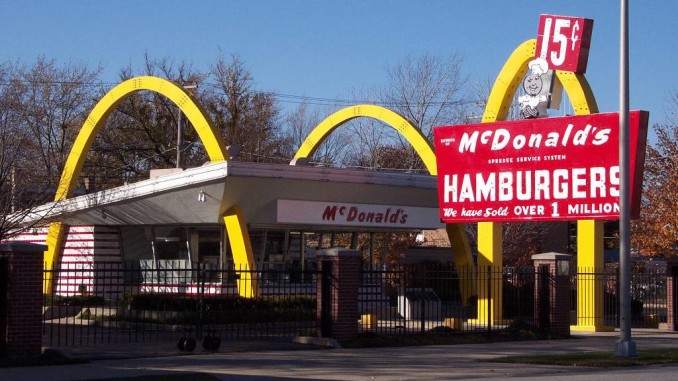
The high cost of college makes people think that most faculty are overpaid. Let me debunk this myth. Nearly all funds from recent tuition hikes, state-allocation increments, and record-breaking fund raising do not go to most educators.
I’m a tenured professor of history of science and mathematics at the University of Texas at Austin. I finished high school in 1988. What if instead of attending college I had worked at McDonald’s?
The company brags about opportunities for promotion. Many managers started as cashiers. So suppose I worked five years as a cashier, five as shift manager, 10 as assistant manager, and, after a total of 20 years, became a manager.
In 1988 a cashier earning federal minimum wage, $3.35, working 40-hour weeks, earned $6,968—just above the poverty level. Suppose I got a raise of 10 cents hourly each year, except when minimum wage increased. I’d earn just $39,936 in five years as a cashier.
Those are gross figures, unadjusted for inflation. You can make different assumptions, but consider this simple scenario.
Promoted to shift manager, I’d earn $59,984 over five years. Next, as assistant manager’s earnings would still be low: just $22,672 in 2003, when the National Average Wage Index was $34,065. Working 10 long years as an assistant manager, I’d earn $225,888. With minimal raises, as restaurant manager I’d gross $227,517 in five years.
McDonald’s gives some employee benefits. One meal per shift, say, 250 meals per year, amounts to $28,125 in 25 years.
Total: $581,450, before deductions for Social Security, Medicare, income taxes, and so on.
What about my real earnings?
As a student and postdoc, I worked several jobs: in computer graphics, tutoring Spanish, residence-hall staff, assistant at a labor library, waiter in two restaurants, editor, and washing dishes at a co-op. In those part-time jobs, I grossed $54,714, counting housing and meals at dorms and the co-op. Plus, I was a teaching assistant in seven courses, grossing $23,333.
I was a postdoc at the Smithsonian, MIT, Harvard, Boston University, and Caltech. My fellowships totaled $171,555, including funds later from the University of Texas.
I taught at Caltech followed by eight years at UT: instructor, lecturer, assistant professor and associate professor, grossing $420,786. Plus payments for talks, television appearances, book reviews: $7,290. I published four books and a teaching manual: $24,324 in royalties.
The running total is $702,002. I also received scholarships from the University of Puerto Rico, Vassar College, New York University, and the University of Minnesota, totaling $51,235—all put toward tuition bills. But the total costs of tuition were $68,221, so subtract the difference. Or subtract my student loans: $45,000 during two years at NYU. And 10 and a half years in Puerto Rico, New York, and Minnesota, all requiring tuition, university fees, books, supplies, computers, printing fees: about $2,500 per year, so subtract $26,250. Also, I moved to distant cities to continue as student and postdoc; roughly $1,300, seven times.
My total gross: $621,652. That’s it—25 years in universities, including nine part-time jobs. Annual average gross income: $24,866.
McDonald’s suggests that employees find a second job.
Since I did not take that into account, we should not count my income from jobs that were outside of universities. If so, my academic earnings were $609,413.
Compare that with $581,450 at McDonald’s.
Predictably, I earned more as a professor than I might have made as an employee at McDonald’s. What is really surprising is that it took me 25 years to do so.
For 24 years I earned less: $522,753 versus possibly $533,556 at McDonald’s, counting meals in both. The important point is that these last two figures are in the same ballpark.
The comparison is about annual pay. Comparing earnings per hour, it’s worse. Ever since starting graduate school, I’ve worked roughly 60 hours per week, even during summers, mostly because of constant research and writing, without which I would have never earned tenure. Comparing hourly earnings, I would have earned more as a 40-hour fast-food employee than in academia in 25 years.
Suppose I had studied education.
In 1992, I’d begin as a schoolteacher, earning the national average starting minimum salary of $22,505. The American Federation of Teachers says teachers take about 14 years to reach the national average salary. So let’s assume annual raises, until I reached the national average of $48,809 in 2006. At that pace, in 2012-13 my salary would be $60,082 (as a professor it was $71,500). My total gross as an average schoolteacher would be $867,165, minus my college costs, roughly, $10,000.
Compare: $857,165 as an average teacher for 21 years, against my actual lifetime earnings of $621,352, including nine part-time jobs.
For more than 20 years, my income was similar to a fast-food worker’s. I even usually ate fast food, using discount coupons.
Is my example significant?
Yes, because most college educators earn less than me. Lacking fair jobs, most work as instructors, lecturers, or adjuncts, earning half as much as tenure-track professors. Non-tenure-track faculty now constitute about 70 per cent of all faculty at degree-granting institutions. Most of them earn less than if they worked in the notoriously low-wage fast-food industry.
I myself was an instructor and lecturer for four years, and had I not managed to enter the tenure track, then by now I would have made roughly $420,000, much less than my potential $581,000 at McDonald’s.
Legislators and college administrators should know the living conditions of most college educators, to help them.
Costs of tuition have reached extraordinary heights nationally, but is that increase going to most educators? My impression is that nearly all the funds from recent tuition increases, state-allocation increments, and record-breaking fund raising are not going to compensate most faculty. Where does this money go? I still do not understand. But it seems parallel to the working conditions of fast-food employees: the corporations earn much, but that money is not going to the cooks or the cashiers.
Alberto A. Martínez is a Professor of History at the University of Texas at Austin.
Versions of this article appeared first in the Austin American-Statesman and The Chronicle of Higher Education, and in Italian translation in Vita.


You are missing out on one big point. Which is sure, after everything considered you are only making a little more going to college and doing all that stuff. but what you are not considering is the fact that you were spending 25 years doing something way way better than working at a McDonalds. I have a BA, but I also remember what it was like working at McDonalds when I was 16. Hovering over a grill in the summertime is not worth the $7.55/hour I was making at the time. You also are not considering the fact that McDonalds employees don’t get any real benefits (medical/retirement) unless they are salary. University professors only work 9 months out of the year, and get benefits. When you adjust for hours worked, Teachers and professors make a shit load of money.